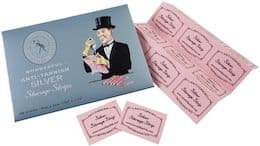
-----
Silver plated copper parts are turning brown
Q. I am a quality control intern and I am investigating some problems my company has had with silver cyanide plated copper parts that we get from one of our suppliers. The two problems we have had are oxidation (parts turning brown) and copper sulphate ⇦ on eBay or Amazon [affil link] (blue crystallization on the parts). I know that sulfur can accelerate the oxidation process and our parts are shipped to us in cardboard boxes which could contain sulfur. What other elements (environmental or other packaging techniques) could accelerate this process? We have had instances where our silver plated parts looked fine before we shipped them, but were brown when they arrived to our customer. Concerning the copper sulphate, I have heard that even if you buff away the blue crystals they will still come back because the copper sulphate is constantly reacting and eating through the silver plating. Is this true? Is there any way to neutralize or stop the blue crystals after they have been removed? Do the blue crystals affect the conductivity of current of the silver plated parts? Finally, how long does it take, typically, for the crystals to form? Maybe environmental factors affect that time span. Any feedback to any to the above questions or a suggested book or website for more information would be greatly appreciated. Thank you for your time.
Chad AdlerQuality Control Intern - Columbia, Missouri, U.S.A.
2007
A. Base preparation (Cu parts) is most important. After bright dip with suitable acid preparation, neutralize the parts with cyanide dip followed by silver strike plating (with low metal high cyanide) and then finally plate good thick silver plating. Also use Anti-tarnish available in the market which will not affect conductivity and give longer life against oxidation during storing and transportation.
Best regards,

P. Gurumoorthi
electroplating process chemicals - Chennai, Tamilnadu, India
Q. Hi, I'm an intern with a company that produces circuit breakers. We use copper parts that have been plated with silver cyanide. We are having big problems with these parts turning brown when we receive them at our plant. We have received containers of parts that will have 2 or 3 perfectly plated parts, but the others will all be brown (oxidized). Also, it's only the top half turning brown. These parts arrive in totes and are set in a foam insert to prevent them from rubbing against each other. The lower half that was in the foam is perfectly plated while the top half is brown. What's happening here? I'm wondering if oxidation of these types of parts is caused by something that wasn't rinsed off well enough during the plating process or if it's the environment that the parts are stored in. Maybe it's a combination of both. What are the major factors that contribute to the oxidation of silver cyanide on copper parts? I know there are additives that are put on parts after plating to prevent oxidation, but if the plating is good there shouldn't be any oxidation or need for such additives. Any information about the causes of oxidation on these types of parts would be very helpful since the internet hasn't helped much with my search. Thank you for your time and feedback.
Chad Adler [returning]Quality Control Intern - Columbia, Missouri, USA
|
|
A. Silver and copper diffuse into each other rapidly. You MUST have a diffusion barrier. I recommend nickel plate.  Robert H Probert Robert H Probert Technical Services Garner, North Carolina  A. You seem to have answered your own question. You say that the parts on the top of the tote always have bad (brown) plating but those below the foam do not. Now a little deductive reasoning will tell you that the parts on top have been exposed to something the rest have not. I m sure the plater will tell you they have all been finished the same and treated the same, therefore, the only variable is the atmosphere the top parts are exposed to Gene Packman- Great Neck, New York A. Hello Chad, Process Engineer - Syracuse, New York A. Silver plated parts tarnishing during shipment is a very common problem. some ways to correct it are:  Pat Mentone St Paul, Minnesota 2007 |
Q. Hi, I am also a quality control intern in a company of commutators and I am investigating a similar problem as Chad.
We are producing copper base for commutators which are sent for silver plating to some other company. One batch came back with small amount of some blue corrosion on hardly accessible places. We made a SEM analysis of crystals which in most cases shows big amount of potassium (more then 50%), other elements are copper (probably from the base), silver from plating and some elements in traces.
We suggest that these crystals are some kind of copper salts but the problem is potassium. We know that it's used in big amounts in baths for silver plating as potassium cyanide, but I didn't find any answer what exactly are these crystals, because of potassium. The only thing I found on internet is Copper-potassium Oxalate dihydrate.
The amount of substance is very small (4 hours for scratching 0,3 micrograms of sample) so it's very hard to make some decent analysis. We are thinking of XRD also but we have to pay for this.
I'd be very thankful for any idea.
- Ljubljana, Slovenia
November 6, 2012
Ed. note: This RFQ is outdated, but technical replies are welcome, and readers are encouraged to post their own RFQs. But no public commercial suggestions please ( huh? why?).
Q. We are making silver plated products; however, the product becomes yellowish or tarnished. We use copper as the material.
We need solution for tarnish but we have to follow regulation from our buyer that they be nickel, lead and cadmium free.
Can anyone give me solutions how to cover this problem?
Thank you.
- Jakarta, Indonesia
October 25, 2013
A. Hello Yolita,
Silver is going to tarnish whether you have a barrier plate between the copper and the silver or not. Most platers use an anti tarnish following the silver plate. A reputable precious metal supplier can assist you with an anti tarnish solution.
Process Engineer - Mesa, Arizona, USA
Silver plating turning brown
Q. Why would silver plating turn brown during plating? We never had this happen before.
charity mclain- manvel, Texas
August 20, 2014
A. Hi Charity,
Despite the reason is unknown which might due to organic stuff adsorption, our experience is to apply hot DI rinse (~60 deg C) for few minutes after silver plating follow by hot air or cold air knife drying and then silver deposit color will restore whitish after dried.
Regards,
David

David Shiu
- Singapore
A. Hello Charity,
You mentioned that the Ag plating was turning brown "during plating". If you hadn't seen this before something in the chemistry is different. First you have to rule out metallic contamination. If your in house wet lab is not able to check for metallic contaminants, most all of reputable Ag plating solution suppliers can do the analysis for you. I have seen cases where city water was added to the tank instead of DI and the bath was contaminated with Fe. You also want to rule out that there is no drag - in from other processes that are metallic in nature. In addition, Ag plating solutions need carbon treating every so often. This will reduce the short chain organics that may be present in the bath. I gave you quite a bit to take action on, but unfortunately sometimes there is no single fix in a plating process so you can be up and running in a few hours or so. Good Luck!
Process Engineer - Phoenix, Arizona USA
A. Good day Charity.
It's funny you mention the silver plating turning brown during plating. I would check the carbonates. Hope your'e not using stainless as anode material, as this will cause the carbonates to sky rocket.
Are you using a wetting agent? This will help somewhat as a grain refiner.
- Whitby, Ont., Canada
Q. I have a question that is related to this brown discoloration. Recently, at my company we have been electroplating small materials, of brass and copper, with a silver electroplating solution that does not use cyanide. The solution is from "gold plating solutions" and it is suggested that a stainless steel anode is used.
After electroplating I noted that the subject that was plated would have bright silver on the side closest to the anode, while the opposite side had a duller silver that almost seemed to show the brass when held in hand (using a cloth that does not shed particles or dust).
Why is the discoloration only apparent on one side of my subject?
- Charleroi Pennsylvania
September 3, 2020
A. Hi Anna. If I am understanding your situation correctly the problem is that you need two anodes -- one on each side of the object.
Plating thickness at any spot is, with only minor simplification, directly proportional to electroplating current at that spot ... and the current essentially takes the path of least resistance. Very little if any plating is expected on the side opposite a single anode.
Luck & Regards,

Ted Mooney, P.E. RET
Striving to live Aloha
finishing.com - Pine Beach, New Jersey
Ted is available for instant help
or longer-term assistance.
Q, A, or Comment on THIS thread -or- Start a NEW Thread
